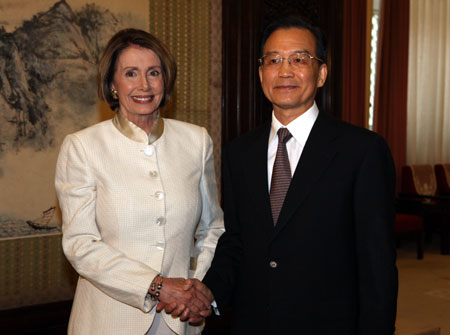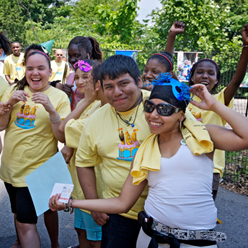We’ve all heard that eating locally is one way to reduce your environmental impact. But what about donating locally? In the urban wilds of New York City, a new non-profit is betting that locally based, small-scale giving can have a big eco-impact.
Ioby, whose name stands for “in our back yards,” connects people working on neighborhood-level projects with community members who can physically and financially support them. At ioby.org, launched this month by co-founders Erin Barnes, Cassie Flynn, and Brandon Whitney, individuals or groups post project descriptions and budgets, and interested donors contribute to the project of their choice. Here’s their introductory video:
Within its first 10 days of existence, ioby successfully facilitated the funding of the first three of its 40 listed projects: a Boy Scout proposed and executed an environmental awareness fair, a community garden got a compost education class off the ground, and another grassroots group undertook a park cleanup and revegetation project in Queens. It’s all part of an effort, says Barnes, to get people connected to their surroundings and invested in the future.
The concept that powers the organization’s work is known as microfinance. As a philanthropy model, it’s not new, but in recent years it’s gained momentum online, with popular sites focusing on education and international development projects. Ioby is the first microfinance site to focus on funding local environmental projects.
Fueled by their successes so far, ioby’s founders — who met at the Yale School of Forestry and Environmental Studies and have called New York City home since graduating in 2007 — hope to expand the model to other communities around the country, though they acknowledge that it will take a lot more work than they first realized. They recently got together to answer a few questions about where the idea came from, who’s using ioby.org, and how it works.
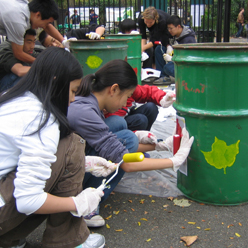 Organizers of “It’s My Park!” day asked ioby followers to help them raise awareness.ioby.orgQ. Do you think ioby’s small-scale model is the future of environmental activism?
Organizers of “It’s My Park!” day asked ioby followers to help them raise awareness.ioby.orgQ. Do you think ioby’s small-scale model is the future of environmental activism?
A. Barnes: A lot of environmental work comes from national campaigns, and all of those efforts are really important. But I think one of the things that we miss is the groups themselves in the neighborhoods, recognizing their own environmental problems, proposing their own solutions. Ioby helps small, community-based groups like neighborhood associations and block associations. It gives them a website, it gives them a storefront, it gives them a cash register, a place where they can talk about these issues to the general public.
I actually think that this is a pretty powerful tool for grassroots organizing. You can reach a lot of people – that’s what social networking does. You engage them by telling them the stories about projects that are happening in their own neighborhoods. You ask them for $20 or three hours on a Saturday afternoon. And I think at that point you have a dedicated lifelong member who wants to make sure that half a block of green space is protected into the future.
Flynn: The people that go onto ioby.org, they get to see what’s going on in their neighborhood and they get to choose a project that is meaningful to them.
Whitney: Ioby really is about local places and helping people either rediscover or discover for the first time that the environment isn’t something that’s abstract or far away, and that it’s mostly about what’s right around you.
Q. How do people get projects on ioby?
A. Whitney: You go to ioby.org. It’s very easy to find the application there. You create a login first, and it’s a pretty short series of questions. It’s not a very onerous process, we don’t think. We take about two weeks to review [the project] and make sure it meets all of our criteria, and then we get back to you with our answer and we post it. We have worked with groups to make an initial idea that didn’t completely meet our criteria, or had a huge budget, into something better suited for our site.
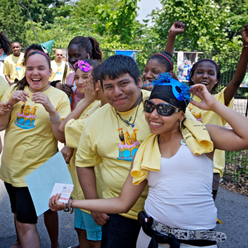 To help residents explore the undiscovered trails of northern Manhattan, Hike the Heights sought funds and volunteers.ioby.orgQ. What kind of projects are you most excited about?
To help residents explore the undiscovered trails of northern Manhattan, Hike the Heights sought funds and volunteers.ioby.orgQ. What kind of projects are you most excited about?
A. Barnes: There’s so many. The Rockaway Waterfront Alliance is a good one. It’s a rainwater harvest system that they want to install, and that’s actually just $345. It’s about storm water management, reducing non-point source pollution from flooding. The All People’s Garden on the Lower East Side needs $2,000 to remove some serious concrete debris. There’s a CUNY-Baruch honors student who is proposing to build a green roof on his school’s building. Groups are composting at McCarren Park in Brooklyn, gardening in abandoned lots, boating in the East River, and hiking through Northern Manhattan. There’s just so many projects on the site I can’t keep track of them.
Q. Who’s using ioby so far?
A. Barnes: The project groups that are using ioby are really various. Some of them are 501(c)3s, some of them are not. One group is Columbia University’s public health department, and another is Sustainable South Bronx, and one is a school teacher in Washington Heights. There’s a lot of community gardens, and there are some that just focus on one neighborhood, like Trees Not Trash Bushwick.
Q. How do you ensure a funded project gets completed?
A. Barnes: Our project groups do the fundraising [at ioby.org] and then, as the project is underway, they post updates. They post photos and they talk about when volunteers come out and plant some trees and clean up some debris … At the end, when the project is completed, they submit a report and write about lessons learned, or what they would have done differently, or advice to other groups, and they put that on the website [where it’s available to the public].
Q. How did you come up with the idea for ioby?
A. Barnes: We copied already successful models and applied it to the idea of doing local environmental work. A lot of the other wonderful, fantastic, online micro-philanthropies that are hugely, wildly successful are about someone really far away giving money to something that they’re really far away from. We were thinking that with the environment being something that people have a personal connection to, if we encourage people to donate to something locally then they’re investing in the future of their own neighborhoods.
Q. Do you have plans to expand ioby to other cities?
A. Whitney: The short answer is yes. Although we’ve found over the past year that it takes an incredible amount of work to build the capacity to engage with the hundreds of groups that we’ve talked to thus far just in one city. And so it’s going to be a process of expanding city by city, and sort of picking some key places first.
Q. Do you really think small, local environmental projects can make a difference when we face such vast environmental problems?
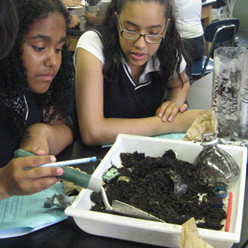 One teacher is seeking support so students can test soil and water quality.ioby.orgA. Barnes: You’re talking about New York City. You’re talking about a city with the carbon footprint of Ireland. You’re talking about this massive place where if all these people make a small individual effort it can make a huge, huge impact. All you have to do is get one eighth of all of New York City residents to help plant a tree each and then you have a million trees.
One teacher is seeking support so students can test soil and water quality.ioby.orgA. Barnes: You’re talking about New York City. You’re talking about a city with the carbon footprint of Ireland. You’re talking about this massive place where if all these people make a small individual effort it can make a huge, huge impact. All you have to do is get one eighth of all of New York City residents to help plant a tree each and then you have a million trees.
Flynn: I think one of the things that ioby really believes in is that a lot of small actions can lead to big change. We hear a lot about these huge environmental problems. “An Inconvenient Truth” came out, and a lot of people learned there’s this big problem going on out there. Now that we have this information, what’s the next step? People want to know how to get involved. And these are people that don’t come necessarily from an environmental background. They want to learn more, and they want to get involved, and they can go to ioby and they can do these smaller projects that do add up to big change.
Q. It sounds as if you’re equating environmentalism with community building.
A. Flynn: Ioby tries to tap into this idea that environmentalism can be what you care about. A lot of people, especially in New York, are very connected to their space. We’re very proud of our borough … And I think ioby is providing this space where you see all the great things that are going on around you in a place that you really care about.
Barnes: I think that environmentalism has always been about the things that are immediately around you. It’s the streets and sidewalks we walk on every single day, it’s the subway we take to work, and it’s that poor little tree that’s barely able to sprout out of the sidewalk. It’s hotdog stands and soccer fields. That’s our environment. If you clean it up, and you put your blood and sweat into that, and you plant some trees, you are going to become a steward of that for the rest of your life. This is about transformational environmentalism, where we become environmentalists for life.
Editor’s note: Stephanie Paige Ogburn attended graduate school at the Yale School of Forestry and Environmental Studies along with the three founders of ioby.org. She is not involved in ioby.org in any way other than writing about it as a new model of environmental activism.
